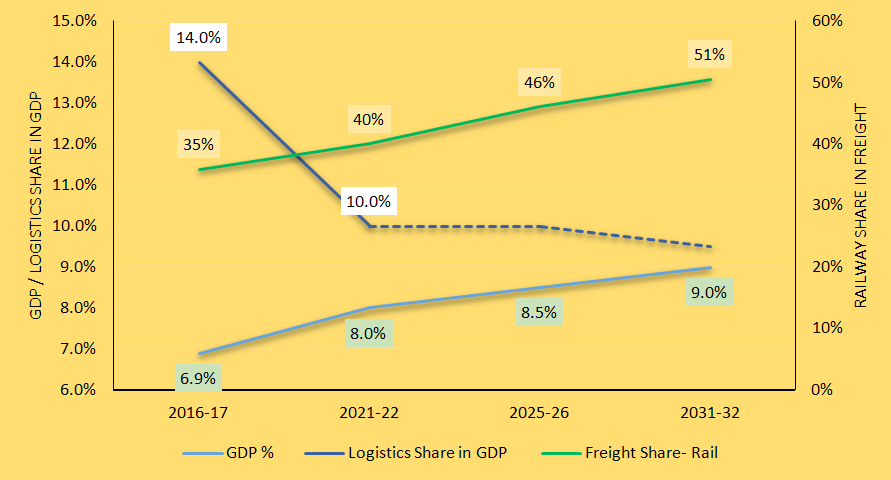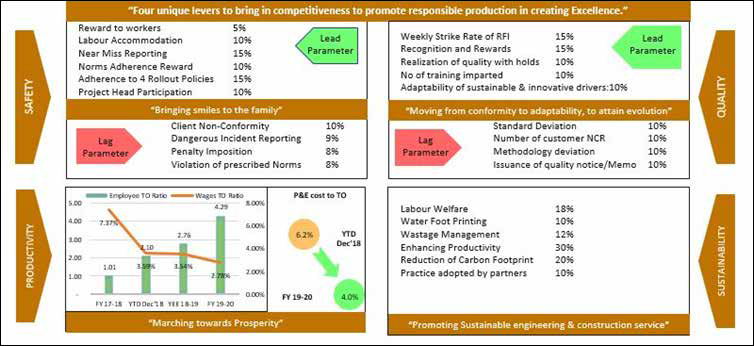
India is one of the fastest growing economy and various stimulus plans are in action to lead the World Economy. The robust economic growth coupled with enhanced household income have enabled increased consumer spending which expects to reach USD 5 Trillion by 2025. The country with population of 1.3 billion living on 2.4% of the world’s surface, necessitates exemplary growth engines to come over significant resource constraints for this rapid journey and environmentally sustainable model of development unlocks transformation towards a low carbon resource efficient economy.
India’s logistic sector is going to play role of big differentiator in creating robust economy in offing. This logistic sector is highly fragmented and having skewed model transportation mix, with 2/3rd of freight moving on roads and 1/3rd on Railway. This is prime focus to meet objective of reducing this component from 14% of GDP to 10% by 2022 and explore further reduction down the line. To drive this, Government of India has created a Logistics Wing to propel economic growth by allocating the task of “Integrated Development of Logistics Sector” to the Department of Commerce and Industry. The same can be achieved by optimizing the current modal mix (Road-59%, Railways-35%, Waterways-6%) in line with international benchmarks (25-30% share of Road, 50-55% share of Railways, 20-25% share of Waterways) and promote development of multi modal infrastructure. Transportation services form a third of the cost of logistic chain and railway component shall be continuously evolved to attain double its share in transportation segment over period. Logistics Performance Index of India has improved, and this focused freight corridor shall be continuously consolidating its position to yield rapid economic growth as well becoming efficient logistic segment in par with countries such as USA, Germany, Japan.
The government has taken initiatives in making an effective ecosystem for Dedicated Freight Corridor to act as an adrenaline in freight traffic. Study reveals that improvement in logistic sector will result in (10% decrease in indirect cost) about 4 per cent reduction in prices of Indian goods making them more competitive globally and 5% to 8% growth in exports.

Tata Projects Limited, is one of the fastest growing and the most admired Infrastructure Company, being associated in executing prestigious seven corridors of eastern and western under Dedicated Freight Corridor Corporation of India limited and contributing directly towards nation building.
Testimony to our unique execution capabilities such as Mechanization & Technology, Project Excellence Drivers, focused management approach in creating customer delight, resulted in award of coveted “Taking Over Certificate” from DFCCIL for two of its corridors named Jaswant Nagar to Chamrola & Chamrola to Khurja with cumulative route of 214 Km. Both corridors will be dedicated to nation in terms of commercial operation soon.
The huge fleet of machinery & equipment, pool of domain specialist & subject matter experts, engineering par excellence, astute Project Manager and result oriented task force constitutes a formidable team to deliver YOY productivity of mammoth 15 million m3 earthwork, 0.30 million m3 concreting, 1.25 million m3 blanket laying, 1.0 million m3 ballast laying & 350 TKM of track linking and thereby acts as enabler of Accelerating India’s Progress.
Four unique drivers are the excellence propeller of our business, as is evident that all key sustainable parameters are being implemented, right from good health, decent work, innovative applications, reducing inequalities, reduce/reuse/recycle & productivity to create a culture of stabilizing life under water and on land to facilitate rapid transmutation of economic growth of the country.
As close to quarter of energy related global greenhouse gas emission comes from the transport which are projected to enhance substantially in years to come. Sustainable transport promotes economic growth, improve accessibility, achieving better integration of economy while respecting the environment, social equality, health, resilience of cities, urban rural linkages and productivity at rural areas.
Rail Transport emits 28 grams CO2 equivalent per MT per KM of transportation as compared to 64 grams in case of road transport.
The cumulative GHG emission over a period of next 30 years in Non-DFC scenario would have been 582 Million-ton CO2 while in DFC scenario it would be 124.5 Million-ton CO2, thus leading to approximately 4.5 times more GHG emission over a period of 30 years as well lower India’s cumulative emissions from current level by factor of 33-35% by 2030.
Tata Projects Limited in Railway Infrastructure is committed to:

“Achieve pinnacles of EFFICIENCY through greater EMPHASIS on ENGINEERING to drive continual EVOLUTION. Synergize ENDURING EFFORTS and EMOTIONS of EVERYONE to EXCEL in an optimised ECONOMY Focussed towards promoting clean ENERGY and reducing EMISSIONS to safeguard planet EARTH.”
Thus, our mandate is well focused in establishing thirteen “E-Factors” to ultimately reach “THE PURPOSE”. Nature has created logic to only protect emotions and ecology is the symbol of all emotions, we possess. This highest form of emotions come from all why, how, what to achieve Sustainable Development Goal 13 “Climate Action” to balance the ecology, shall be objective of each human being.
Author :
Mr. R K Pandey, Head Transportation,Tata Projects Limited
This article is a part of our September 2019 Magazine: Subscribe to our Magazine Today!

